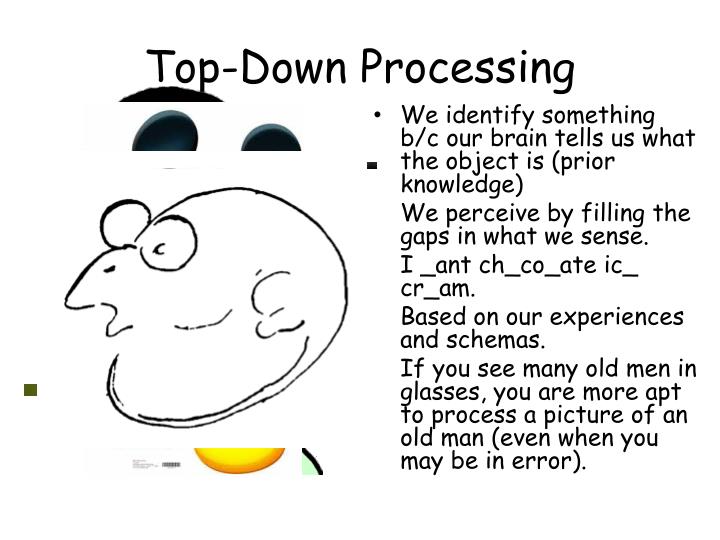

Only later in time, through recurrent feedback processing, volitional control based on expectancy and goal set will bias visual selection in a top–down manner. He is interested in mental health and well-being.The present paper argues for the notion that when attention is spread across the visual field in the first sweep of information through the brain visual selection is completely stimulus-driven. Robert Haynes did his degree in psychology at the University of Hertfordshire. Thus, previous knowledge, experience, and expectations are the driving forces behind top-down perception. (Gregory, 1970)Īs clear by know that during top-down processing, experience, prior knowledge, and expectations are all crucial factors in creating the perception of new stimuli. The process of interpreting incoming information according to one’s prior knowledge, experiences, and expectations.The driving force behind perception in bottom-up processing is the stimulus one is currently experiencing in one’s external environment. The process of gathering inputs from our environment to build perceptions by using the sensory information that we have received.īottom-up processing does not require any prior learning, so perception is solely determined by stimuli received from one’s environment.Therefore, we can determine the distance between us and something passing us by observing the speed with which it moves. Whenever we are travelling on a fast-moving train, objects closer to us seem to pass by more quickly, while objects further away pass us comparatively slowly. This argument is supported by motion parallax. Thus, prior knowledge or past experiences may not affect the perception of the stimulus. shape, size, distance, etc.),about the stimulus. In his theory, he explained that the environment can provide sufficiently detailed information (e.g. Gibson, a strong supporter of the bottom-up approach to perception, argued that perception is not subject to hypotheses rather, perception is a direct phenomenon. In his opinion, they serve simply as examples and are not images seen in a person’s normal visual surroundings. Gregory’s explanation was criticised by psychologist E.J. There is only one direction in which the signal travels. The visuals of the football and all other information about the stimulus is transmitted to the visual cortex in the brain from the retina. Suppose a football stands in the centre of a person’s field. Therefore, the word ‘data-driven’ can be used when describing perception.

Bottom-up processingĪs opposed to the top-down approach, in the bottom-up processing approach, the perception starts at the sensory input, the stimulus. In Gregory’s view, incorrect hypotheses can be formed by the brain when faced with a visual illusion, such as the Necker tube, which may result in an inaccurate perception. Consequently, a perceptual hypothesis is created about it as a result of this event. The stimulus is created based on memory and experience that is related to it. When it comes to visual perception, he argues that 90% of the visual information is lost before it reaches the brain. For him, one’s perception is determined by their best guess or hypothesis regarding the world around them. Gregory explained that using prior experience and knowledge of a stimulus helps us draw inferences. Gregory’s TheoryĪccording to renowned psychologist Richard Gregory,the perception process is a constructive one that relies on the top-down processing. The brain may be able to comprehend the gist of a paragraph by using the context provided by the surrounding words. You will have an easier time understanding what the author wants to say if you read the whole paragraph instead of reading the words separately. In simple words, based on the knowledge we have, our brain fills in the blanks and anticipates what will come next.Īs an example, you are presented with a paragraph that is written in a illegible handwriting style. Our perceptions are largely influenced by the expectations we have and prior knowledge. As a result of this approach, one’s perception starts with the most general and gradually progresses to the most specific. It is classified as top-down processing when pattern recognition is developed through contextual information. Is there a difference between the two? Yes.

But how can you understand the process of perception? The process of perception can be understood with these two approaches: bottom-up processing and top-d own processing.


 0 kommentar(er)
0 kommentar(er)
